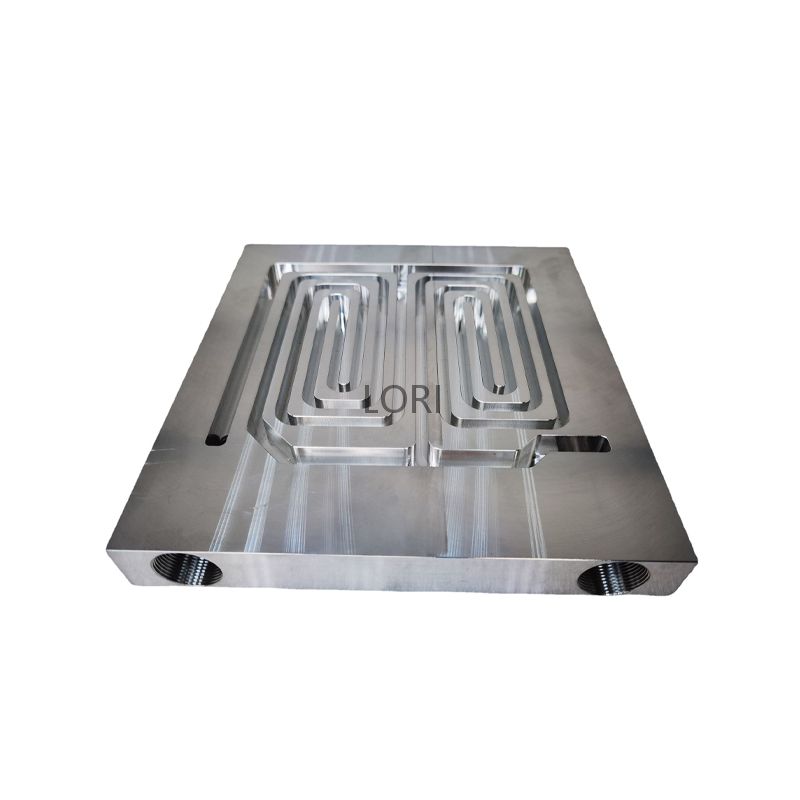What is Water-Cooled Heat Dissipation?
Compared to air-cooling, water-cooling is widely used in new energy vehicles, industrial electronics, and other industries due to its flexibility, compactness, reliability, high efficiency, and maintenance-free features. A complete water-cooling system generally includes a heat-absorbing device (in direct contact with the heat source), a liquid transport pipe, a heat dissipation device (such as heat sinks and fans), and a liquid transport pump. Common water-cooled heat dissipation products in the industry include water-cooled plates, water-cooled housings, and water-cooled enclosures. The basic structure and heat dissipation principle involve bonding a baseplate with a cover plate to form a sealed cavity through friction stir welding. The cavity features inlet and outlet nozzles for water, which connect to the water transport pipe and pump. Water circulates through the system, rapidly spreading heat across the water-cooled plate to prevent heat accumulation and control the operating temperature of the product.
Why is Friction Stir Welding the Best Choice for Water-Cooled Heat Dissipation Products?
Friction stir welding is based on the extreme plastic deformation of metal materials. When the stir pin is slowly inserted into the base metal, friction generates heat, and the pressure applied by the stir head causes mechanical deformation of the metal to form a dense weld seam with a homogeneous grain structure.
Compared to traditional metal melting welding methods, friction stir welding offers several advantages: high strength, minimal leakage, and minimal deformation. The weld seam produced by friction stir welding is nearly free from pores and leaks, and the joint strength is significantly higher than that of melting welding. This welding process is highly suitable for the fabrication of water-cooled heat dissipation products.
What Are Common Water-Cooled Heat Dissipation Products?
Common water-cooled heat dissipation products include new energy motor housings, control enclosures, battery tray cooling plates, and high-power electronic product cooling plates.
Manufacturing Process and Considerations for Water-Cooled Plates
1. Product Design:
The design and manufacturing process for water-cooled plates require consideration of various factors, including material selection, flow channel structure for heat dissipation, and whether the product structure meets welding process requirements. During the product manufacturing process analysis phase, it is crucial to ensure: 1) the gap and flatness of the cover plate and base plate meet the requirements for friction stir welding; 2) welding depth affects welding deformation, and the location of welding tail holes must be predetermined; 3) welding is generally a pre-process, and machining allowances must be left for post-weld CNC milling; 4) for products requiring special surface treatments, the impact of welding position color differences must be considered.
2. Machining:
Water-cooled plates are core components of heat dissipation control systems, with high requirements for internal flow channel structure, surface roughness, and part accuracy. Additionally, the flatness and fit of the water-cooled cover plate also affect the subsequent welding process. Other factors to consider during machining include surface reinforcement treatments for flow channels to increase rigidity and wear resistance.
3. Welding Processing:
Water-cooled plates are fabricated by welding a base material with flow channels and a cover plate to form a sealed cavity using friction stir welding. Initial samples can be created using simple fixtures, but for batch production, it is necessary to custom-design a set of automated welding fixtures for efficient and stable production.
4. Product Testing:
Water-cooled heat dissipation products generally require leak testing. During initial sample welding, a cross-sectional cut of the weld seam is usually inspected for hidden defects, and weld seam depth can be measured. For mass production, basic leak testing is typically required, and additional tests such as metallographic analysis, tensile testing, and operating condition testing can be performed based on customer needs. For high-value products, non-destructive X-ray testing may also be conducted.
5. Post-Welding Processing:
Post-welding processes include surface milling and treatment to meet requirements for corrosion resistance, wear resistance, decoration, or other special functions.
What Customized Water-Cooling Product Services Can Lorithermal Provide?
Product Solutions:
We have extensive experience with water-cooled heat dissipation products and friction stir welding, offering customers assistance in providing solutions and design optimization for water-cooled products. We can support clients in the early stages of product development and sample testing.
Friction Stir Welding Processing:
We offer sample creation and batch processing for friction stir welding products, including automated welding fixture design and turnkey project services.
OEM Processing:
We provide precise machining, friction stir welding, post-weld processing, professional testing, and surface treatment for OEM manufacturing.
Machining Equipment:
Lorithermal has two main workshops: a friction stir welding product processing center and a CNC machining center. We possess over ten friction stir welding machines of various types, including five-axis, large, medium, and small gantry machines, and C-type machines. Additionally, we have high-precision CNC machining equipment, lathes, milling machines, drilling machines, and grinding machines to fully meet the industrial requirements for friction stir welding products and OEM manufacturing services.







